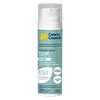What's inside
What's inside
 Key Ingredients
Key Ingredients

 Benefits
Benefits

 Concerns
Concerns

 Ingredients Side-by-side
Ingredients Side-by-side

Water
Skin ConditioningC12-15 Alkyl Benzoate
AntimicrobialButyl Methoxydibenzoylmethane
UV AbsorberOctocrylene
UV AbsorberButylene Glycol
HumectantEthylhexyl Salicylate
UV AbsorberMethylene Bis-Benzotriazolyl Tetramethylbutylphenol
UV FilterDimethicone
EmollientPolyglyceryl-3 Methylglucose Distearate
EmulsifyingBis-Ethylhexyloxyphenol Methoxyphenyl Triazine
Skin ConditioningVp/Eicosene Copolymer
Adipic Acid/Diglycol Crosspolymer
Tribehenin
EmollientPhenoxyethanol
PreservativeDiethylhexyl Butamido Triazone
UV AbsorberDimethiconol
EmollientDecyl Glucoside
CleansingPotassium Cetyl Phosphate
EmulsifyingParfum
MaskingMethylparaben
PreservativeEthylparaben
PreservativeAcrylates/Vinyl Isodecanoate Crosspolymer
Emulsion StabilisingTocopheryl Acetate
AntioxidantVitis Vinifera Seed Oil
EmollientGlycerin
HumectantTetrasodium EDTA
Potassium Hydroxide
BufferingPropylene Glycol
HumectantXanthan Gum
EmulsifyingSodium Ascorbyl Phosphate
AntioxidantPanax Ginseng Root Extract
EmollientDipropylene Glycol
HumectantWater, C12-15 Alkyl Benzoate, Butyl Methoxydibenzoylmethane, Octocrylene, Butylene Glycol, Ethylhexyl Salicylate, Methylene Bis-Benzotriazolyl Tetramethylbutylphenol, Dimethicone, Polyglyceryl-3 Methylglucose Distearate, Bis-Ethylhexyloxyphenol Methoxyphenyl Triazine, Vp/Eicosene Copolymer, Adipic Acid/Diglycol Crosspolymer, Tribehenin, Phenoxyethanol, Diethylhexyl Butamido Triazone, Dimethiconol, Decyl Glucoside, Potassium Cetyl Phosphate, Parfum, Methylparaben, Ethylparaben, Acrylates/Vinyl Isodecanoate Crosspolymer, Tocopheryl Acetate, Vitis Vinifera Seed Oil, Glycerin, Tetrasodium EDTA, Potassium Hydroxide, Propylene Glycol, Xanthan Gum, Sodium Ascorbyl Phosphate, Panax Ginseng Root Extract, Dipropylene Glycol
Ingredients Explained
These ingredients are found in both products.
Ingredients higher up in an ingredient list are typically present in a larger amount.
Also known as Avobenzone, this ingredient is a chemical sunscreen filter that provides protection in the UV-A range.
Avobenzone is globally approved and is the most commonly used UV-A filter in the world.
Studies have found that avobenzone becomes ineffective when exposed to UV light (it is not photostable; meaning that it breaks down in sunlight). Because of this, formulations that include avobenzone will usually contain stabilizers such as octocrylene.
However, some modern formulations (looking at you, EU!) are able to stabilize avobenzone by coating the molecules.
Avobenzone does not protect against the UV-B range, so it's important to check that the sunscreen you're using contains other UV filters that do!
The highest concentration of avobenzone permitted is 3% in the US, and 5% in the EU.
Learn more about Butyl MethoxydibenzoylmethaneMethylene Bis-Benzotriazolyl Tetramethylbutylphenol (Tinosorb M) is a hybrid and broad-spectrum UV ingredient. It is both a UV absorber and filter.
UV absorbers are an agent that absorbs UV rays. They protect your skin by using chemical reactions to convert UV rays into heat and energy. UV filters physically reduce the amount of UV rays from reaching your skin.
Tinosorb M covers a range of 280-400 nm and is photostable. This ingredient is neither oil or water soluble.
Tinosorb M is not available in the US. However, it is available in the EU and Asia.
It's sister, Tinosorb S, is set to be approved in the US by late 2025 (fingers crossed!).
Learn more about Methylene Bis-Benzotriazolyl TetramethylbutylphenolOctocrylene protects skin from sun damage. It absorbs UV-B with peak absorption of 304 nm. It is a common sunscreen ingredient and often paired with avobenzone, a UVA filter. This is because octocrylene stabilizes other sunscreen ingredients by protecting them from degradation when exposed to sunlight. Octocrylene is a photostable ingredient and loses about 10% of SPF in 95 minutes.
Octocrylene also acts as an emollient, meaning it helps skin retain moisture and softens skin. It is oil-soluble and hydrophobic, enhancing water-resistant properties in a product.
Those who are using ketoprofen, a topical anti-inflammatory drug, may experience an allergic reaction when using octocrylene. It is best to speak with a healthcare professional about using sunscreens with octocrylene.
The EU allows a maximum of these concentrations:
Learn more about OctocrylenePhenoxyethanol is a preservative that has germicide, antimicrobial, and aromatic properties. Studies show that phenoxyethanol can prevent microbial growth. By itself, it has a scent that is similar to that of a rose.
It's often used in formulations along with Caprylyl Glycol to preserve the shelf life of products.